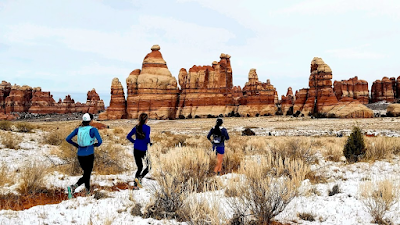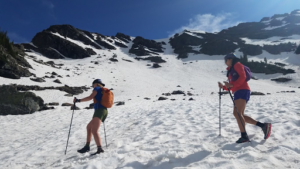
Spotting a “Female” in the Mountains By Sara Boughner
As I walked into a local coffee shop, I was excited to meet up with a good friend who loves to trail run and has stories from several adventures around the world. She was going to tell me about her most recent exploration of the Snowcrest Mountains, a small but stunning mountain range southeast of Dillon, MT. Describing her trip, she recounted a specific run that she did solo, then talked about how she ran into a hunter afterward. The hunter, a male, told her that he was following her with his spotting scope, and thought to himself, “I believe that is a female!” He described how surprised he was to see a woman running by herself in the wilderness.
The Numbers: Women and Trail Racing
In a March 2020 article from Runner’s World, the acclaimed trail runner Hillary Allen asks the question, “Do people associate the outdoors with women?” She comes to the unfortunate and definitive answer of no, and it was clear that the hunter from my friend’s story would concur. While this is likely the case for an array of outdoor sports and recreation settings, trail/mountain running and ultra running is no exception.
When we examine ultra marathons and mountain races on a national scale, the number of women who participate is staggering, amounting to an average of 16% of the field even though more women are running ultras than ever before.1 (The numbers of minorities and women of color participating in trail races is even more dismaying, and deserving of another article entirely.) Missoula, however, seems to go against the grain in this regard, at least with respect to women competing in sub-ultra trail races. Although the average field of women competing in trail races nationally loomed around 20% participation in 2018, a short survey of local sub-ultra trail races shows 56% average female participation in 2019.2,3 While this is a remarkable difference from the national average, and a testament to the inclusivity of our running community, women who run and race trails in Missoula still face similar barriers and challenges as the rest of the United States.
My question is where these barriers to trail/mountain racing and ultra running truly lie, especially for those women who shy away from it in a community like Missoula? Similarly, despite our higher participation in local trail races, what difficulties do we face with getting out the door and into the mountains? A recent Trail Runner article by Zoë Rom highlights the challenges that childcare brings into the picture, and just how limiting it can be for mothers who want to train and set big goals. She cites the Pew Research Center, noting that women can be “time-handicapped,” especially if they are raising families and working. It was found that on average men have approximately 5 more hours of free time in a typical week than women, leaving extra time for training and long runs in the mountains.4 While time is the most identified limiting factor toward training for big goals in my female peer groups, I am inspired by families who equalize childcare and household duties and prioritize their time outside.
Another often cited barrier includes perceptions of safety in regard to wildlife and other humans when out in the wilderness. While true incidents are rare, they should be considered when planning for a run or long adventure. If this is an issue that is stopping you from getting outside, take the steps to empower yourself to navigate a threatening situation. Take a self-defense class, bring along your bear spray, enroll in a wilderness first aid class, and make noise while you travel, especially if you are going alone.
The American Trail Association’s commentary on gender disparity in mountain ultra running proposes that we will increase female participation through storytelling.5 When we see other women finding happiness in mountain running, we will be more likely to think it is possible for us. Similarly, Hillary Allen notes the importance of mentors in her introduction to running. Looking to others who lead by example can open doors previously unimaginable for some women.
The Ins and Outs
An additional element that is not unique to women, though certainly is prevalent, is the complex psychological layer of body image that plays into our motivation or hesitation to run. The National Association of Anorexia Nervosa and Associated Disorders estimates that about 30 million Americans, or about 9 percent of the population, suffer from eating disorders such as anorexia and bulimia, and it is generally accepted that athletes suffer at a higher rate than the general population.6 A 2015 study conducted at the Comrades Ultramarathon found that one-third of women in the race had disordered eating behaviors, involving abnormal thoughts about food and its relation to body image.7 Women like Mirna Valerio show us that there is not one ideal body type for running, and running coaches across the country are flipping the script and advocating for adequate nutrition and body positive thoughts.
Though the relationship of food, running, and body image is a complicated formula for each individual based on their past experiences, cultural norms, and genetics, it is helpful to recognize what commonly motivates us as female athletes. While generalizations can over-simplify, it is broadly observed that female athletes are motivated by intrinsic factors. We tend to value performing an activity for the joy of it, but also put emphasis on the social element and positive feedback.8 This highlights the importance of finding your “why,” and remembering it on the days when you don’t feel great.
Maybe We Need to Reframe Bada**-ery
Ultimately, I wonder about the cultural barriers that prevent women from getting out on trails both locally and nationally. While logistical elements can prevent women from having the time to train for big goals, what are the other social norms that prevent us from even considering that they are possible? Speaking from personal experience, I can attest to self-doubt and a lack of confidence to be “good enough” to make trail racing “worth it.” What I have come to realize, though sometimes struggle to practice in a sport that is immersed in finishing times, is that my pace is not a reflection of my value as a runner or a person.
Though I am inspired by women who win races, accomplish FKTs, and embark on incredible adventures, I often hear the phrase, “She is so bada**.” While I want to recognize and respect the hard work, sacrifice, and commitment that make these achievements possible, I wonder if we can reframe what it truly means to be bada** so that more women could picture themselves in that position. The image of toughness and talent that typically goes along with these stories can set these women apart from the “rest of us,” and too often group them with men. (How often have you heard a top finishing time for a female described in relation to where she finished amongst the male field?) This construct may cause some women to inadvertently avoid making big goals since they may not believe they can attain fast times.
While I do not want to diminish the accomplishment of a podium finish or FKT, I do want more women (myself included) to allow themselves to recognize their self-worth despite where they finish in a race. On the flip side, I also want more women (again, myself included) to have the ability to set big goals and be able to envision themselves accomplishing them with all of the success they dream of. Being bada** doesn’t always mean you ran a fast time, or climbed a tall mountain. Sometimes it means that you got yourself out the door on a day when all you wanted to do was “Netflix and chill.” Sometimes it means you stopped yourself during a workout because your energy levels were just too low. Women are strong. Our bodies and our feet can take us to amazing places in the wilderness. And, at the end of the day, we are capable of more than we think.
So, if you have ever thought that a trail race of any distance, but especially an ultra, was out of your reach, I encourage you to open the door of possibility. Maybe you simply don’t want to run that much, and that is great too. But, if it has ever sounded appealing to you, or you feel the itch of curiosity, take a look at what would need to happen to make it possible. Have the conversation with your partner to allow you the time to train. Make sure you feel prepared to manage your safety in the wilderness. Have a plan to eat a lot and sleep enough. Prepare for your training to avoid overuse injuries. Look to your female friends and mentors who have experience with trail running (there are a lot of them in Missoula). And, most importantly, find your reason for joy with running and hold it close on the days that feel hard.
_____________________
Endnote: This article and the statistics referenced were written in respect to women and trail/mountain running in a pre-COVID world. Clearly, not everyone is in a position to consider races and adventures based on cancellations, closures, shelter-in-place orders, and hardships as a result of the pandemic. Someday (hopefully soon) races will return, even if they will look a little different. In the meantime, there are many other ways to set and achieve big goals.
Additionally, it is worth noting that this article does not capture the challenges facing female BIPOC and LGBTQIA runners, and this is deserving of its own feature with more attention paid to these groups in the research that is currently being conducted on outdoor recreation.
Photo Credits: Forrest Boughner
References:
-
Dawson, A. (2020, Jan 24). More People Are Running Ultras Than Ever Before. Retrieved June 01, 2020 from https://www.runnersworld.com/news/a30430651/more-people-are-running-ultras-study/
-
Allen, H. (2020, March 31). Ultrarunner Hillary Allen Wants to Inspire More Women to Get Out on the Trails. Retrieved June 01, 2020 from https://www.runnersworld.com/runners-stories/a31939860/hillary-allen-women-in-trail-running/
-
Female participation in Montana trail races in 2019: Snowbowl 15k (Missoula), 11 Miles to Paradise (Missoula), Elk Ramble 15k (Missoula), The Rut (28k, 11k, Big Sky), Double & Single Dip (Missoula), Sentinel Hill Climb (Missoula), Don’t Fence Me In 30k (Helena)
-
Rom, Z. (2020, May 07). How Childcare Responsibilities Limit Women’s Participation in Trail Running. Retrieved June 01, 2020 from https://trailrunnermag.com/people/how-childcare-responsibilities-limit-womens-participation-in-trail-running.html
-
Bolt, R. (2019, July 24). Research Presentation: Gender Disparity in Mountain, Ultra, and Trail Running. Retrieved June 01, 2020 from https://trailrunner.com/trail-news/research-presentation-gender-disparity-in-mountain-ultra-and-trail-running/
-
Caplan-Bricker, N. (2017, June 23). The Inextricable Tie Between Eating Disorders and Endurance Athletes. Retrieved June 01, 2020, from https://www.outsideonline.com/2191906/eating-disorders-are-more-common-you-think
-
Folsher, L. et al. (2015). Ultra-Marathon Athletes at Risk for the Female Athlete Triad. Retrieved June 01, 2020, from https://sportsmedicine-open.springeropen.com/articles/10.1186/s40798-015-0027-7
-
Garcia, N. et al. (2017). NSCA Coach, Volume 4, Issue 4: The Perception and Progression of the Female Athlete, (58-60). Retrieved June 01, 2020 from https://www.utrgv.edu/coha-research-academy/_files/images/news/nsca%20coach%204.4.pdf#page=58
 missoulamarathon.org >>
missoulamarathon.org >>

